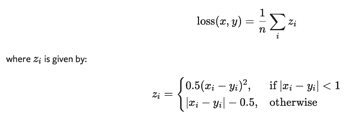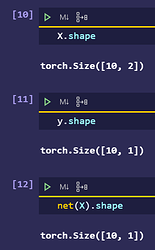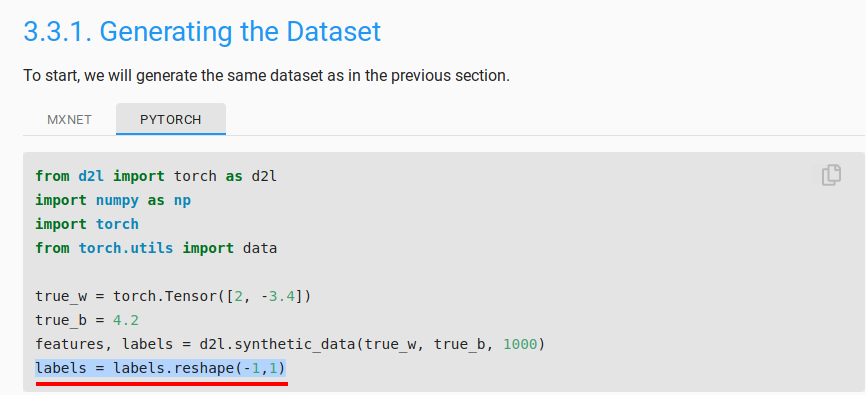Great catch @hy38! We will fix it!
Glad it helped!
Thanks for fixing it!
I’m confused of "size_average and reduce are in the process of being deprecated" .
I need to ask you to confirm that I’m right about reduction ( string , optional ) can replace the others.
Yes reduce is deprecated in pytorch and has been replaced by reduction
-
CLASS torch.nn.SmoothL1Loss(size_average=None, reduce=None, reduction='mean')
- print(net[0].weight.grad())
For more:
Search for accessing the gradient:https://d2l.ai/chapter_deep-learning-computation/parameters.html
I got a problem when running the training code. I got the following warning message:
*/usr/local/lib/python3.6/dist-packages/torch/nn/modules/loss.py:432: UserWarning: Using a target size (torch.Size([500])) that is different to the input size (torch.Size([500, 1])). This will likely lead to incorrect results due to broadcasting. Please ensure they have the same size.*
* return F.mse_loss(input, target, reduction=self.reduction)*
I looked into the code and find that net(X) produces a tensor with shape (500,1) while the label y has a shape (500). I think it should be better to use loss(net(X).reshape(y.shape)) instead of loss(net(X),y)
I think what you say is good but not better.
In example,
You’d better use loss(net(X),y.reshape(net(X).shape).
?Am I right

Thanks for the reply. Why is loss(net(X),y.reshape(net(X).shape)) better? Will it have a faster speed? Cause I think both loss(net(X).reshape(y.shape) and loss(net(X),y.reshape(net(X).shape)) are doing the same thing (i.e. to make sure that X and y are of the same dimension) except they may have different execution time.
Forgive me if I am talking nonsense. I am quite new to deep learning and PyTorch so I am a bit confused. 
In the very first cell of the page, when were generating the data, there is the line:
labels = labels.reshape(-1,1)
This will make the shape of the labels tensor as (1000,1) from (1000) (assuming that you’re using 1000 examples).Since y is a single batch derived from the labels field, it will have a shape of (batch_size,1). Hence, y and the output of net(X) both will have the same shape and there is no need for reshaping.
So the given code is correct and perhaps you must’ve missed this line in your code which caused this warning.
I am quite new too.
Like what Kushagra_Chaturvedy said,
data preprocessing is important for using pytorch API.
I did not see the line
labels = labels.reshape(-1,1)
in the text, to be honest. But I think @Kushagra_Chaturvedy is right. Preprocessing the data before the training will be better right?
?
There is no labels = labels.reshape(-1,1) in the section’s first line.
There is the newest version!:
http://preview.d2l.ai/d2l-en/PR-1080/chapter_preliminaries/autograd.html#grad.zero_()
So in your version, reshape is necessary for net(X) but not for labels.
New too. Wait for pro.
Oh! I was being silly. There IS the line for reshaping. 
Oh. I see it. 
However, which one is quicker ? I think (10,) is quicker than (10,1).
This was better approach, including this line resolved the issue I was having ( loss not decreasing and very high)
I feel puzzled about Q1. If we replace nn.MSELoss(reduction='sum') with nn.MSELoss() and we want the code to behave identically, I think we need to replace ‘lr’ with ‘lr/batch_size’. However, the result seems different. Can anyone tell me what’s wrong here?
I had the same intuition and ran into the same issues on Q1. The question for the MXNET implementation suggested to me that that approach (dividing by batch size) might be correct, but I’ve had no luck so far finding a learning rate that produces results even close to those obtained using the default reduction (mean).
MXNET question, for reference:
If we replace
l = loss(output, y)withl = loss(output, y).mean(), we need to changetrainer.step(batch_size)totrainer.step(1)for the code to behave identically. Why?
edit to updated with further progress
I wasn’t paying enough attention to the code. Dividing the step size by 10 doesn’t account for the fact that the loss that’s actually printed incorporates all 1000 observations. So I was consistently off by a factor of 1000 by not dividing loss(net(features), labels) by 1000 when using sum and comparing to the loss using mean. After incorporating this change, dividing the learning rate by the batch size had the desired results (or at least the same order of magnitude; I haven’t made a single version of this working on exactly the same data as I’m still pretty uncertain about automatic differentiation).
So my big question now is: am I still missing something big? I was unable to find a way get the same output using mean and sum reduction changing only the learning rate. Is there a way to do so? I experimented with many different values and was unable to find a way.
Another edit with more testing
I ran the comparison after setting a random seed and was able to obtain identical (not just same order of magnitude) results with reduction='sum' by dividing the learning rate by the batch size and by changing the per-epoch loss calculation to l = loss(net(features), labels)/1000.
The results were not identical when I changed the learning rate to any other value. So I’ve mostly convinced myself that this approach is correct, and it makes intuitive sense to me. But I do think the question implied this could be solved by changing only the learning rate, so I still wonder if I’m missing something there.


